https://phys.org/news/2020-12-aspirin.html
To develop along the gravitation factor - leaves toward the sun and roots toward the center of the earth - the plant hormone auxin has to be asymmetrically distributed within the root, indicated by a DR5rev::n3GFP fluorescent auxin reporter.
Shutang Tan/IST Austria
When pathogens enter a plant, infected cells set off an alarm before they die. They discharge methylsalicylic acid, which is later transformed into salicylic acid, triggering an immune response. Hence, salicylic acid is a stress signal in plants, but it also participates in regulating plant growth and development. In humans, salicylic acid proved to be useful in a different way: Even in prehistoric times people realized that when they were drinking willow bark tea or taking other willow bark preparations, fever dropped and pain disappeared. Centuries later, scientists developed salicylic acid derivatives such as aspirin and ibuprofen. These so called non-steroidal anti-inflammatory drugs (NSAIDs) suppress the inflammatory response of mammalian cells, thereby making us feel better when we have a cold. But how do they affect plants?
Losing the sense of direction
"When I got the idea, I had a really serious toothache and I had some ibuprofen at hand," explains Shutang Tan, who at that time was a postdoc at the Institute of Science and Technology (IST) Austria working in the group of Professor Jiří Friml. "I simply used the tablets from the pharmacy and I took the same amount as in my previous experiments with salicylic acid. Then, I observed the effect of the ibuprofen on Arabidopsis seedlings." The primary roots of the plant were significantly shorter and instead of growing downward, they were curling up, unable to respond to gravity. Furthermore, the plants developed fewer or no lateral roots at all.
Together with colleagues at the IST Austria and six other research institutions Shutang Tan looked at the effects of 20 different painkillers on Arabidopsis seedlings. "We found that all of the painkillers we tested, including Aspirin and Ibuprofen, were interfering with the auxin flow," explains Tan. The plant hormone auxin is essential for all developmental processes within a plant. It is especially responsible for a plants ability to stretch its leaves towards the sun and its roots towards the center of the earth. So called PIN proteins regulate the flow of auxin from one cell to the other, depending on which side of the cell they are sitting. If the PIN proteins are not at the right location within the cell, the flow of auxin is disturbed, leading to a faulty development of the plant. Hence, the painkillers seemed to interfere with the localization of the PIN proteins. But it didn't stop there.

Within 30 minutes, the painkiller Meclo (meclofenamic acid) causes an aggregation of early endosomes - vesicles that form at the plasma membrane - in the root epidermis (magenta). This might explain the effect of NSAIDs on the trafficking of various plasma membrane-resident cargo proteins, including the PIN2 auxin transporter (green).
© Shutang Tan / IST Austria Credit: Shutang Tan/IST Austria
Complex dynamics within plant cells
Looking closely, the scientists discovered that the effect is not limited to PIN proteins, but that the drugs interfere with the whole endomembrane system, suppressing the movement and trafficking of substances within the cells. The painkillers impair the dynamics of the cytoskeleton of the cells, a network of interlinking proteins, which among many other things gives the cell its shape and is involved in the uptake of extracellular material. Together with Markus Geisler's group at the University of Fribourg, Switzerland, the researchers at IST Austria uncovered that one group of painkillers, including the drugs Meclofenamic acid and Flufenamic acid, directly target an immunophilin-like protein, called TWISTED DWARF1, to realize these physiological and cellular activities.
Furthermore, the scientists were able to show, that NSAIDs have similar physiological and cell biological effects as auxin transport inhibitors—important chemical tools in cell biology, which interfere with the transport of auxin. "It would be very interesting to find out, if these auxin transport inhibitors can also be used as painkillers in animals. That is one big question we still need to answer," concludes Tan. Together with IST Professor Jiří Friml, Shutang Tan, who is now establishing his own laboratory at the University of Science and Technology of China, wants to investigate which additional proteins within the plant are targeted by the painkillers and what pathways they use to do so.
Recommend this post and follow The Life of Earth
https://disqus.com/home/forum/lifeofearth/


No comments:
Post a Comment
Stick to the subject, NO religion, or Party politics